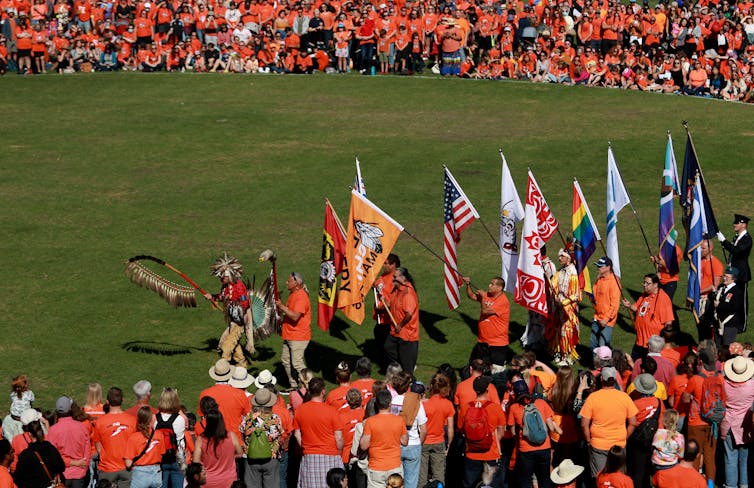Academic writing courses have historically served as a kind of gate-keeping measure. In North America and other settler colonial societies, such courses have traditionally imparted skills and knowledge for succeeding in university as an institution that has privileged Eurocentric forms of knowledge and served elite members of society.
As anti-racist educators like George Sefa Dei and colleagues explain, settler colonialism “imposed colonial theories of knowledge that privileged and superiorized Eurocentric knowledges and denied, denigrated and invalidated Indigenous knowledges ….” Eurocentric educational ideology “continues to inform what is considered formal education in Canada.”
Since fall 2021, the University of Victoria (UVic) has offered a section of a foundational introduction to writing course specifically for Indigenous students. The general foundational writing course meets UVic’s academic writing requirement, so most students will take it in their first or second year.
We designed a specific academic writing course that introduces Indigenous students to the conventions of academic writing and the skills they need to navigate the institution. When we identified “learning outcomes” for this course — what we wanted the outcome of students having taken the course to be — among these, we envisioned that at the end of the course, students would feel a sense of belonging at the university.
Read more: It's taken thousands of years, but Western science is finally catching up to Traditional Knowledge
Why a writing course?
Loren Gaudet, the lead author of this story, is a rhetoric and writing studies white settler scholar who teaches first-year students writing. She focuses on teaching students to understand academic writing as a scholarly conversation they’re entering.
First-year writing courses provide a necessary introduction into the world of academic communication. They equip students with the skills and confidence to add their voices to scholarly discourse.
By leveraging an existing academic writing course that meets the academic writing requirement, the writing course for Indigenous students provided a space to cultivate belonging for Indigenous students who have historically been and continue to be systematically excluded from post-secondary education.

Creating the course
Lydia Toorenburgh, the co-author of this story, worked with many Indigenous students through their studies and staff roles at UVic. Toorenburgh is a mixed settler and Bungi-Metis Two-Spirit person who has served as an Indigenous Resurgence Coordinator at UVic and is a PhD student in anthropology and Indigenous governance.
Toorenburgh learned many Indigenous students struggle to navigate post-secondary education because these institutions require skills, knowledge and ways of knowing that are not intuitive, not readily taught and stem from a colonial orientation.
Toorenburgh wondered how to deliver to Indigenous students:
the knowledge of campus supports and confidence to access these supports;
the skills needed to meet the academic and administrative demands of university;
the feeling that they belong on campus and are valued members of the community.
All of these factors support Indigenous student success.
Toorenburgh recognized the potential of the first-year writing course to deliver these learning outcomes because it is a requirement and a foundational skills course.
‘Belonging’ as learning outcome
By including belonging as a learning outcome, we signalled to ourselves and our students that building community was a valued part of our class time together — and an intentional and deliberate undertaking. We intentionally fostered belonging and community-building in varying ways.
We began every class with a “round”: we sat in a circle together and each person had a chance to share how they were feeling. In an institution that can often be unfriendly and is full of overt and covert barriers for Indigenous students, it is radical to create a class environment built on personal connection and belonging.
We brought representatives for Indigenous-specific supports into the classroom to meet the students and talk with them, rather than just offering links to resources in the syllabus or course. In other words, we prioritized proximity and access to supports and relationships as essential factors in cultivating a sense of belonging for our students.
We also adopted an anti-oppressive grading practice. For us, this meant that student grades were determined by how many assignments the students completed over the term. Students earned an “A” by exceeding expectations and proposing their own additional projects. For example, two of our students created a podcast, “The Power of Indigenous Kinship.”

Student responses
To measure the impact of this course, we surveyed the students at the end of each term. Ninety-one per cent of students strongly agreed or agreed that being in this course section with other Indigenous students made them feel more comfortable in the classroom. Ninety-three per cent strongly agreed or agreed that this made them more comfortable at UVic.
In response to the question: “What worked?” one student wrote:
“I loved having the community that was created in our classroom. I felt a lot of support and love, a very safe space for me.”
These results show that making time and space for belonging has had a direct impact on these Indigenous students.
Dedicated spaces
Spaces that are dedicated to Indigenous students enhance their learning and success. Many institutions are creating dedicated spaces like UVic’s First Peoples House, where the writing course serving Indigenous students has been held, but we argue that we can extend this work beyond resource centres.
Read more: Want to decolonize education? Where classes are held matters
A writing course for Indigenous students, as both a first-year and requirement-satisfying course, provides the opportunity for a homeroom-style class.
Here, instructors can deliver essential curriculum (including practices to foster belonging), introduce students to key resources — and identify and intervene in student struggles.
Finally, we encourage collaborations between Indigenous and non-Indigenous staff, instructors and administrators to be innovative. In so doing, it’s possible to work with present (and often restricted) resources to design and implement creative initiatives for decolonization.

